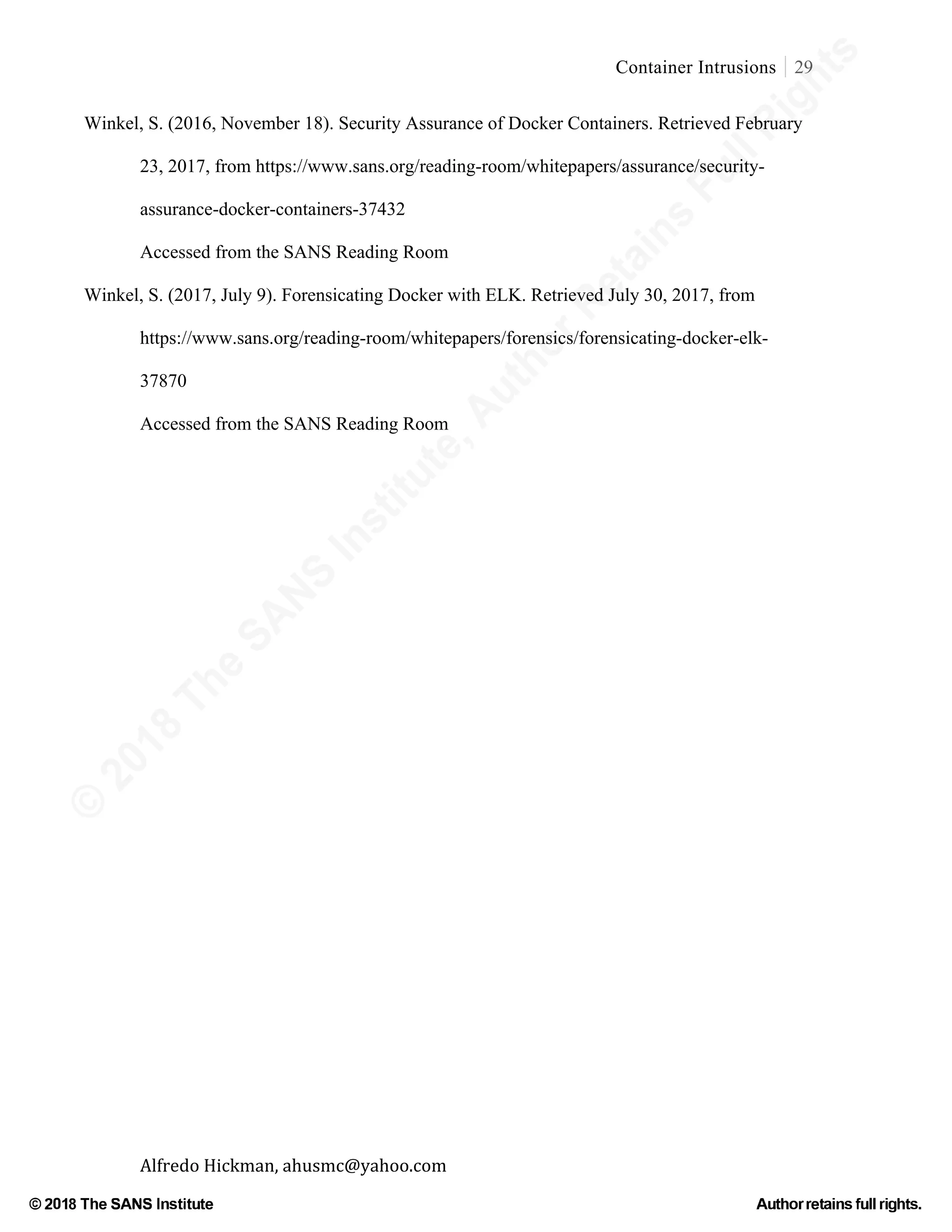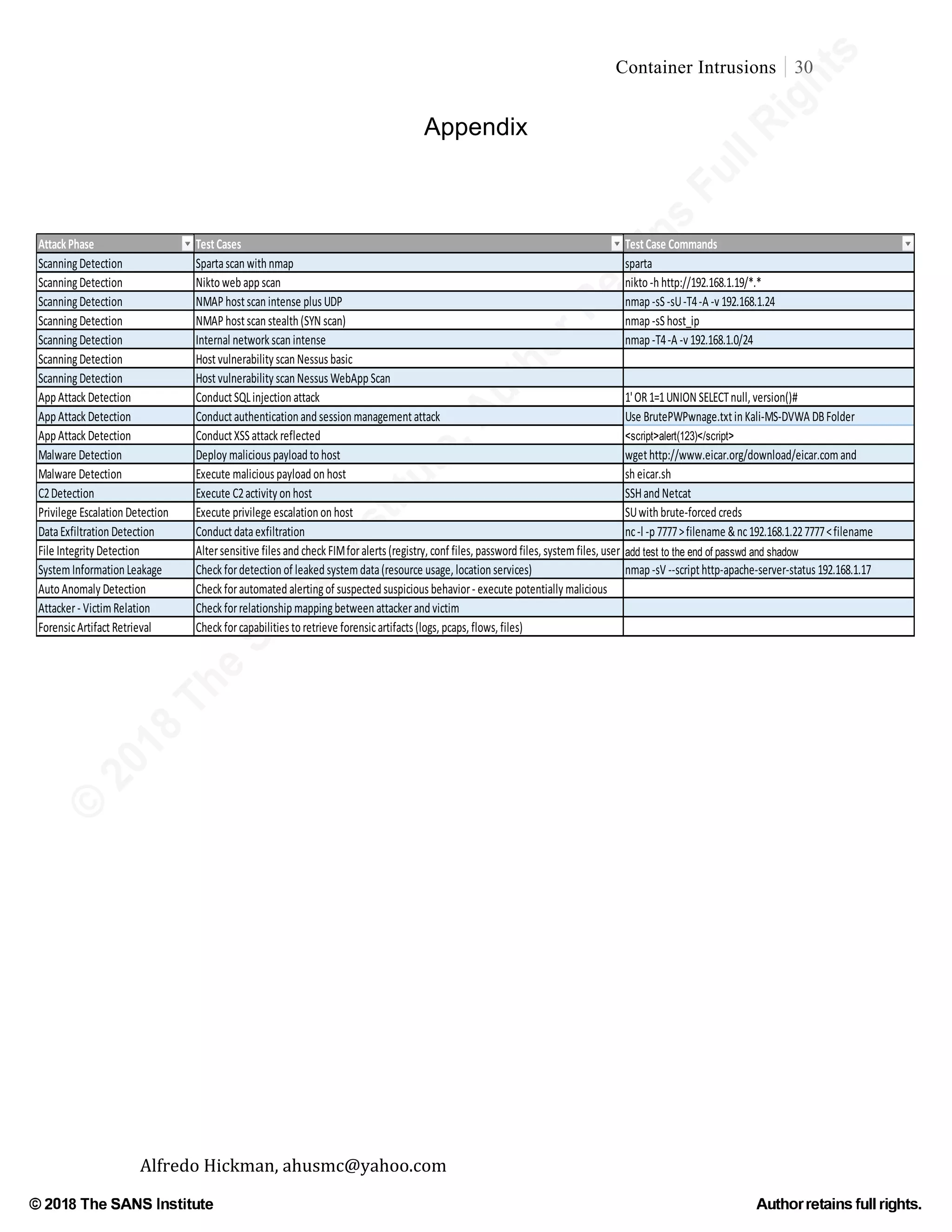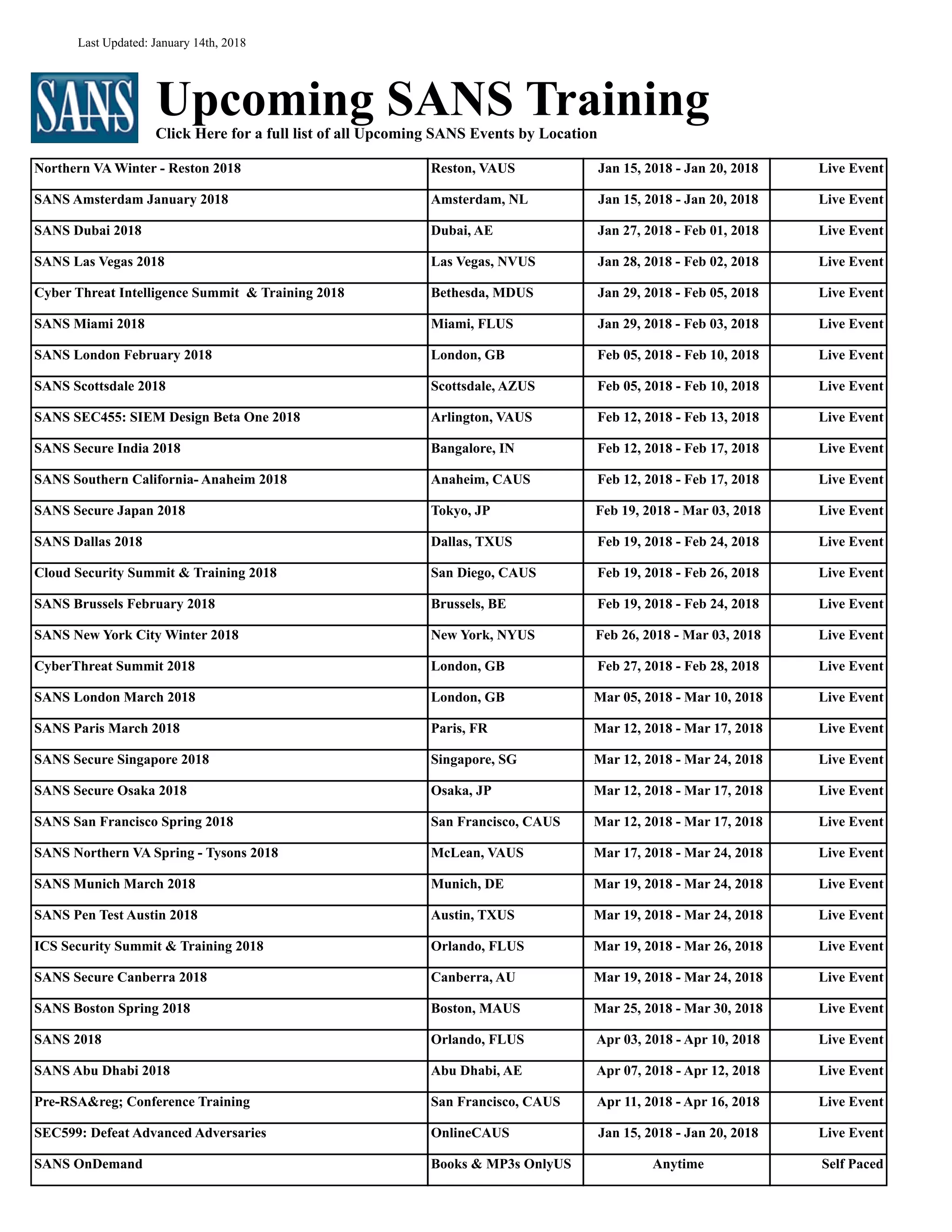This document discusses the unique challenges of intrusion detection and analysis in Linux container environments, highlighting that conventional methods are not directly applicable. It identifies a significant gap in security knowledge and the need for empirical research to develop effective security methods tailored to container technologies. The paper reviews existing literature and methods, advocating for adaptations of traditional intrusion detection approaches and the development of new techniques specific to container networks.
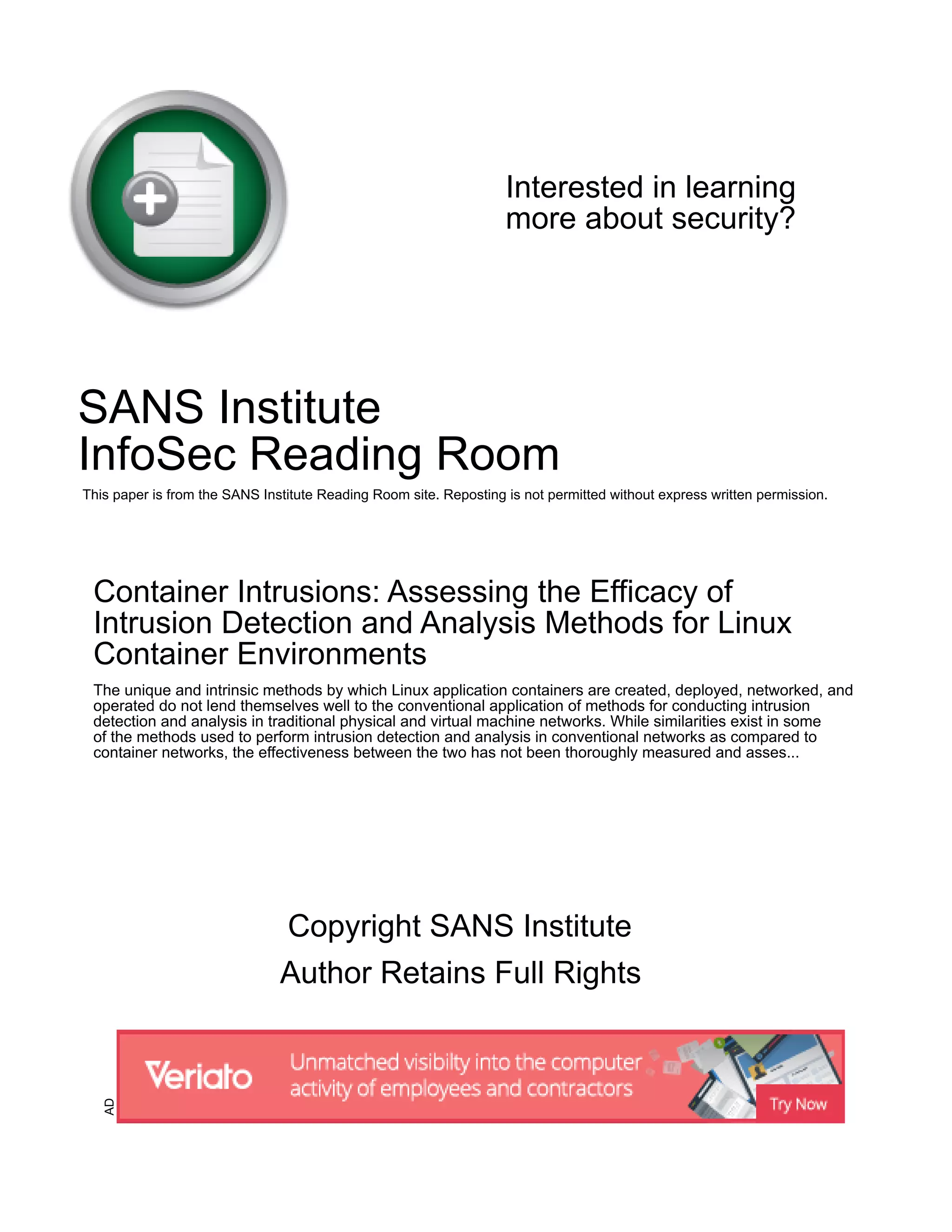

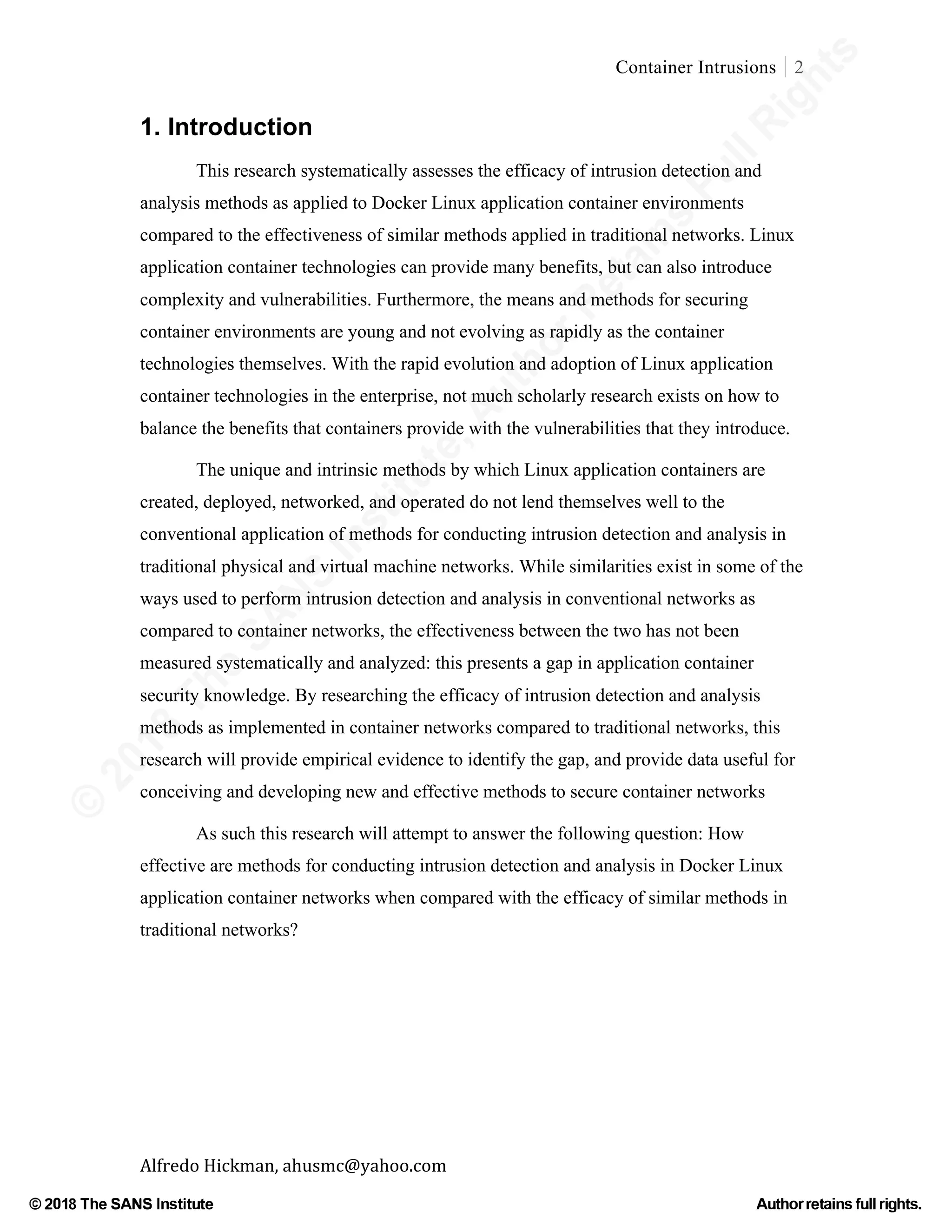
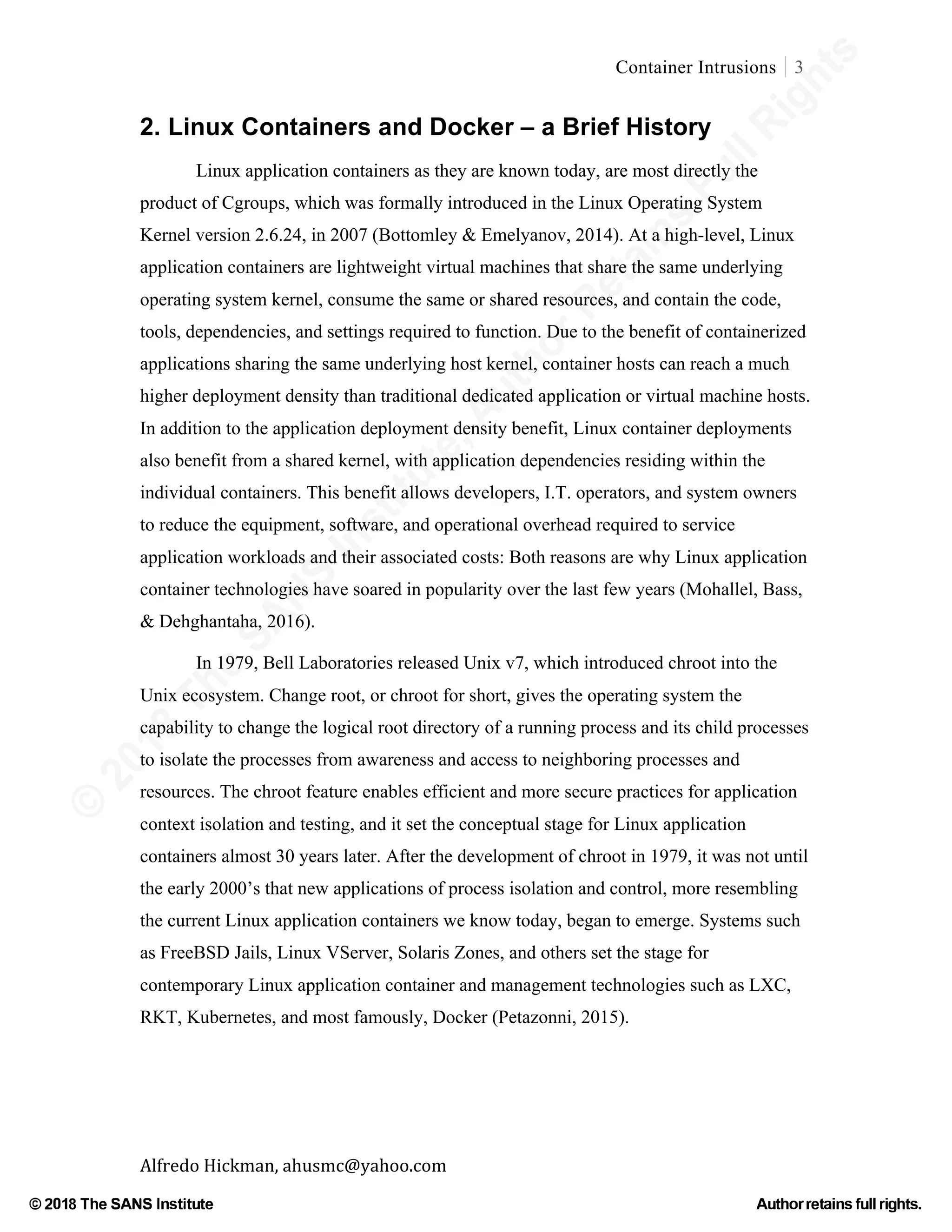
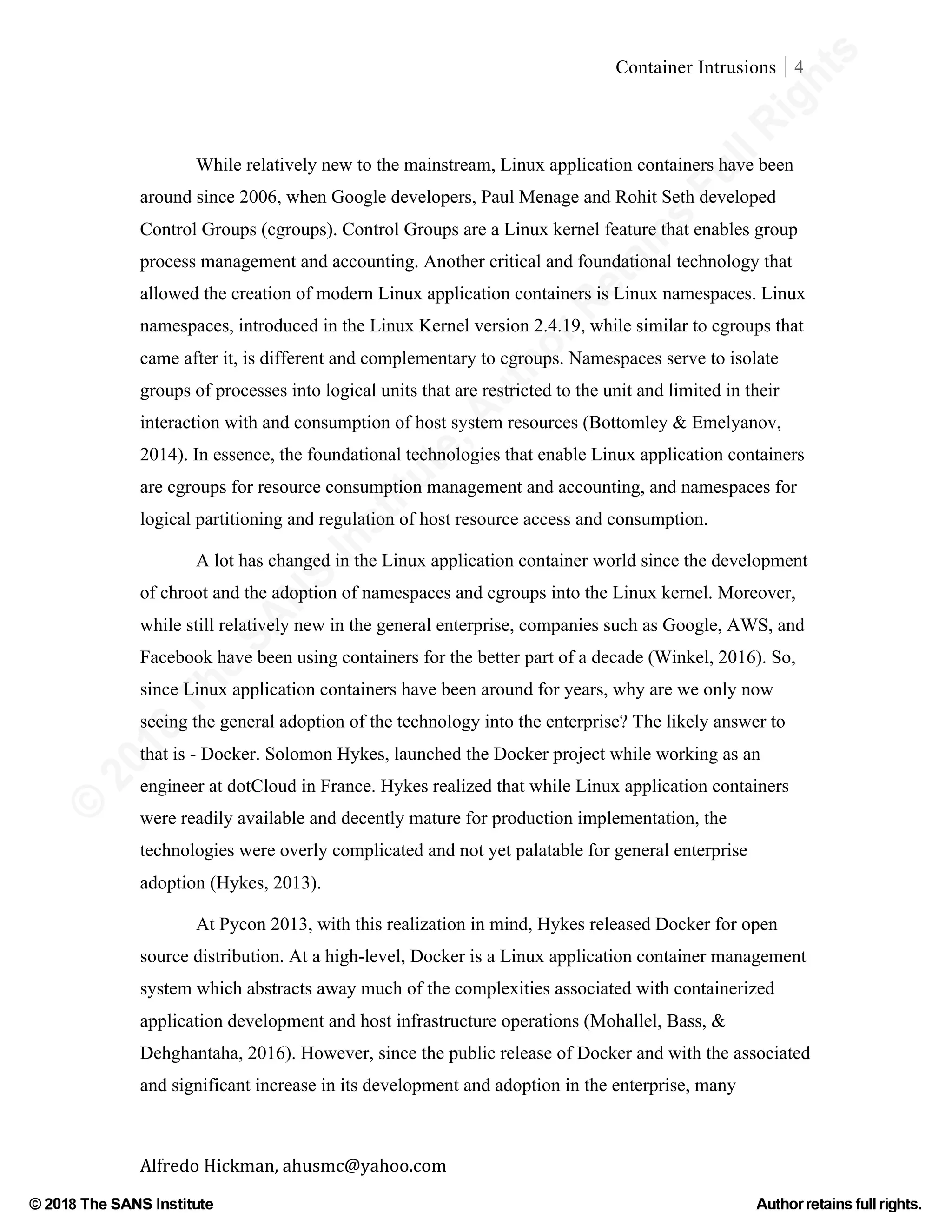
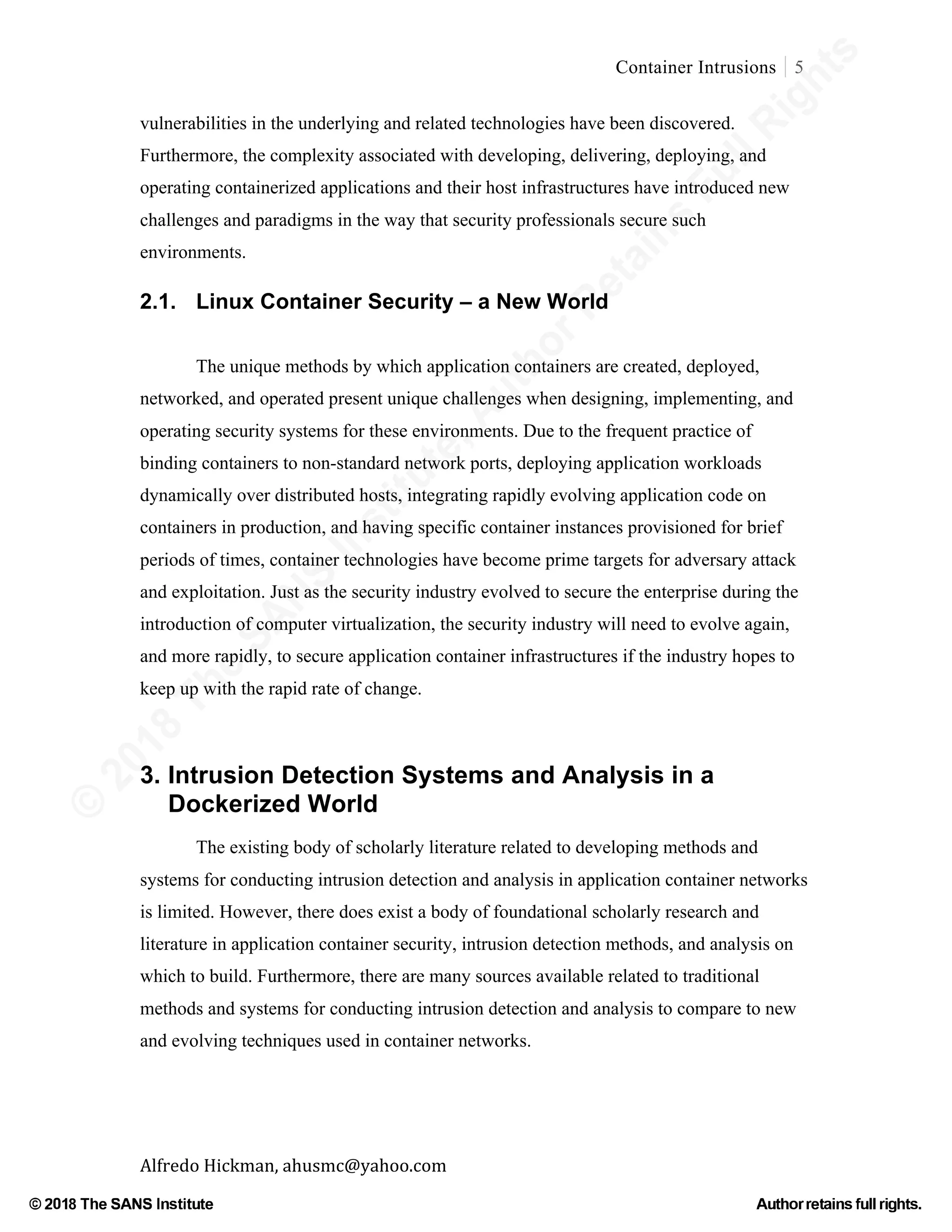
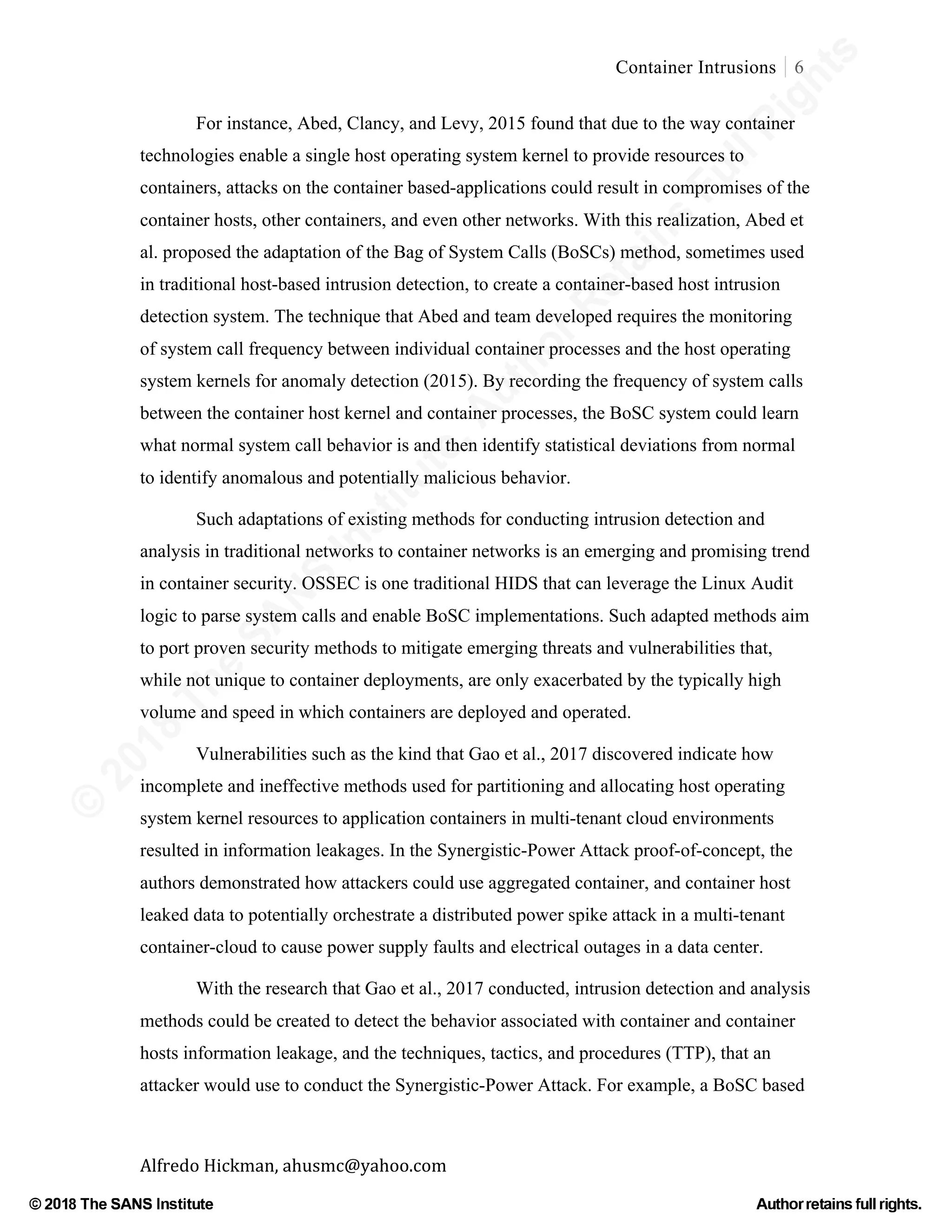
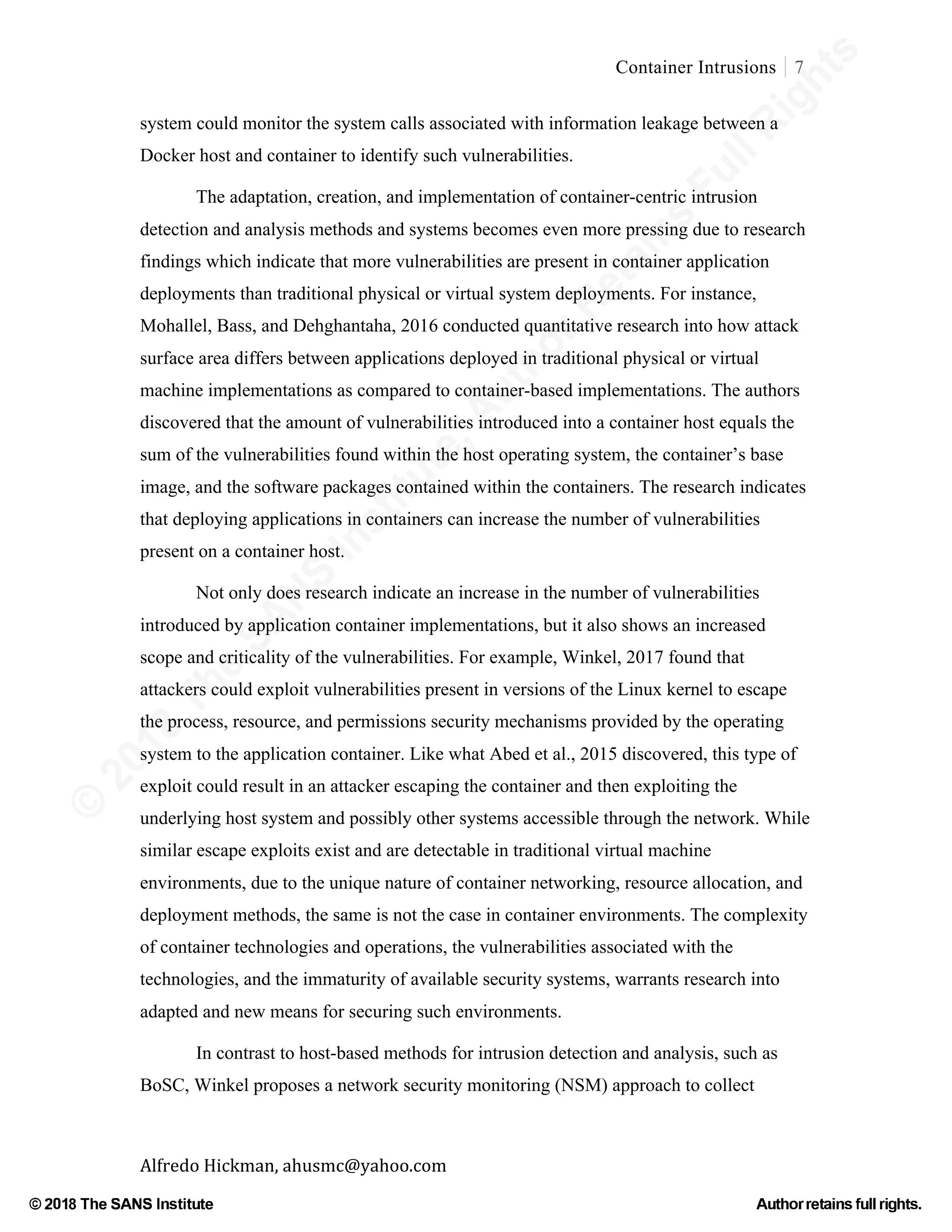
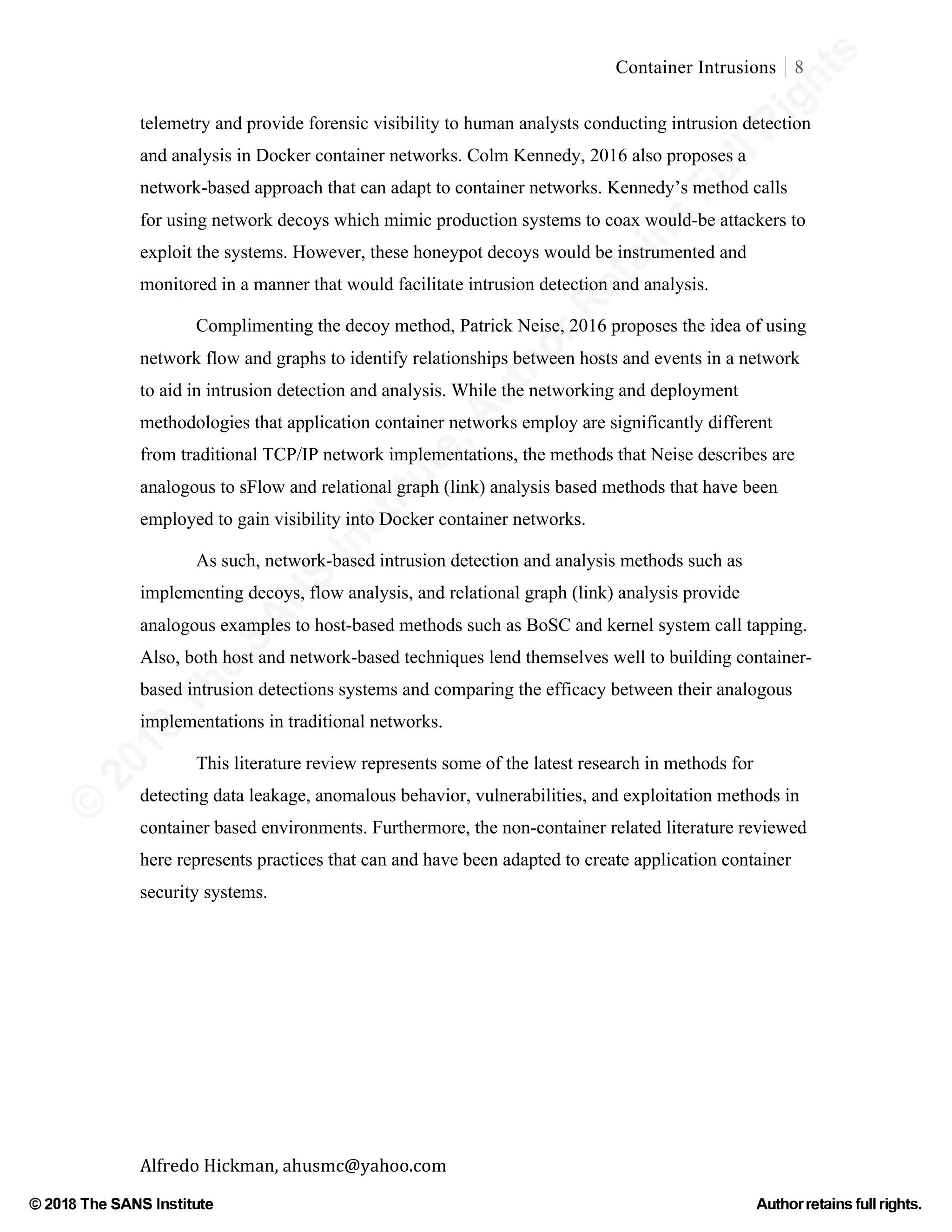


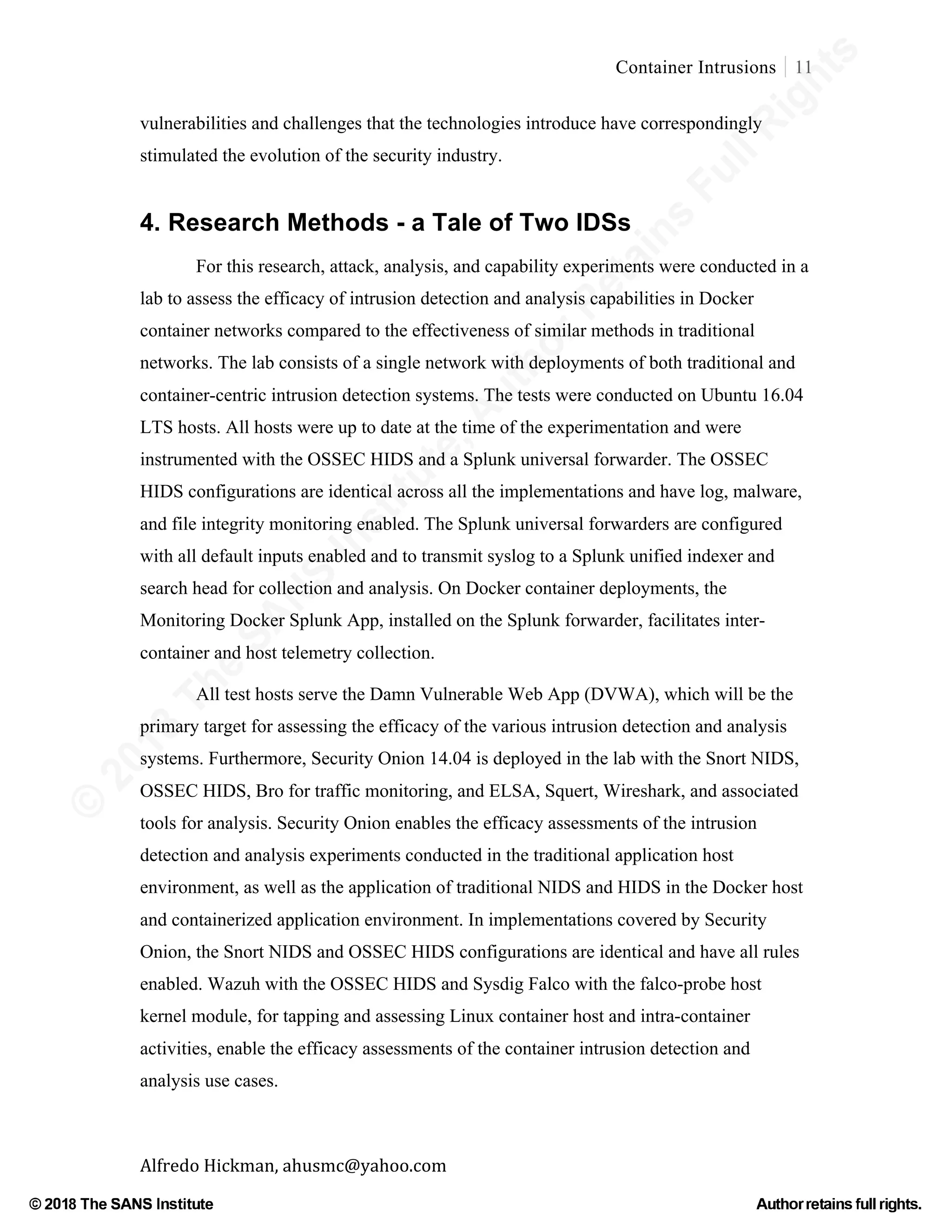
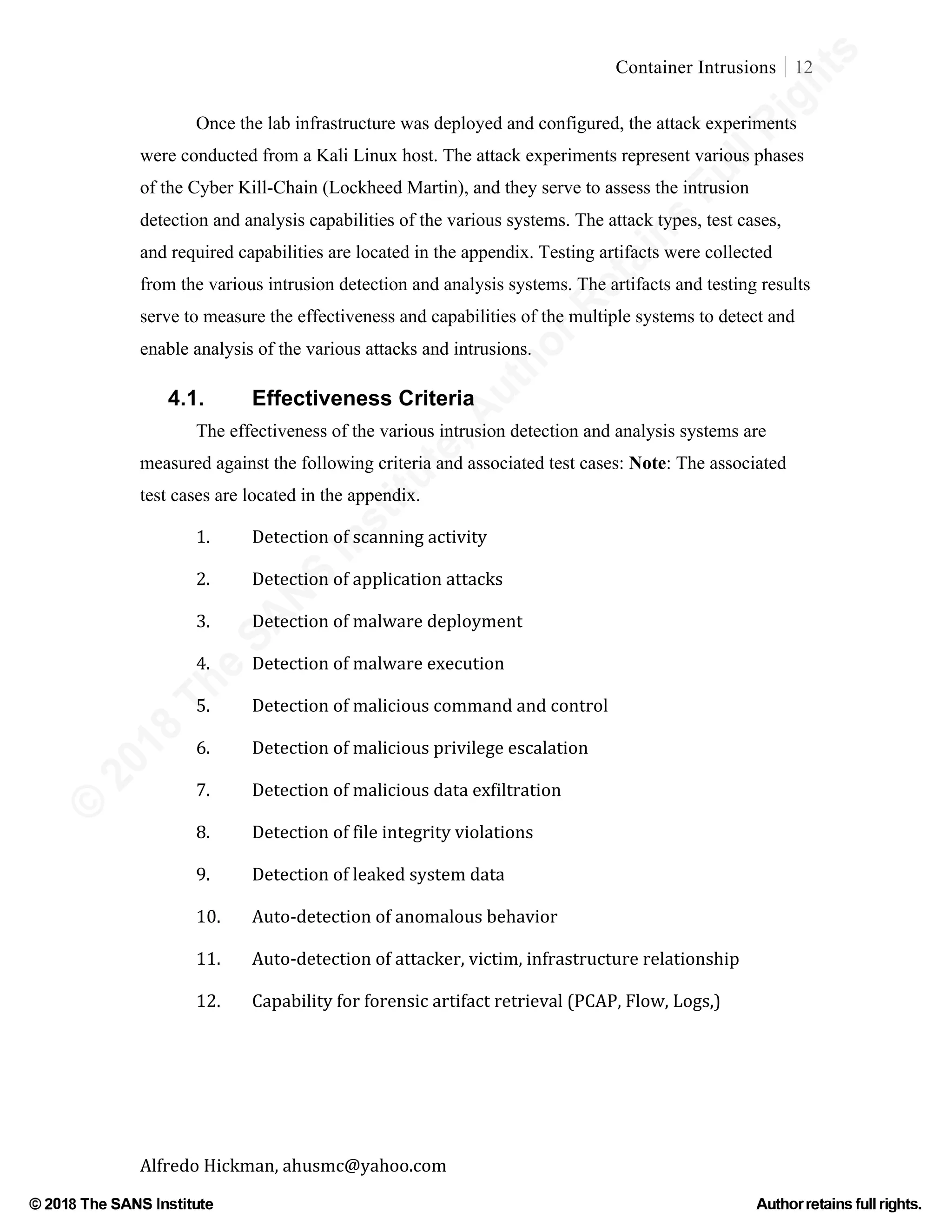
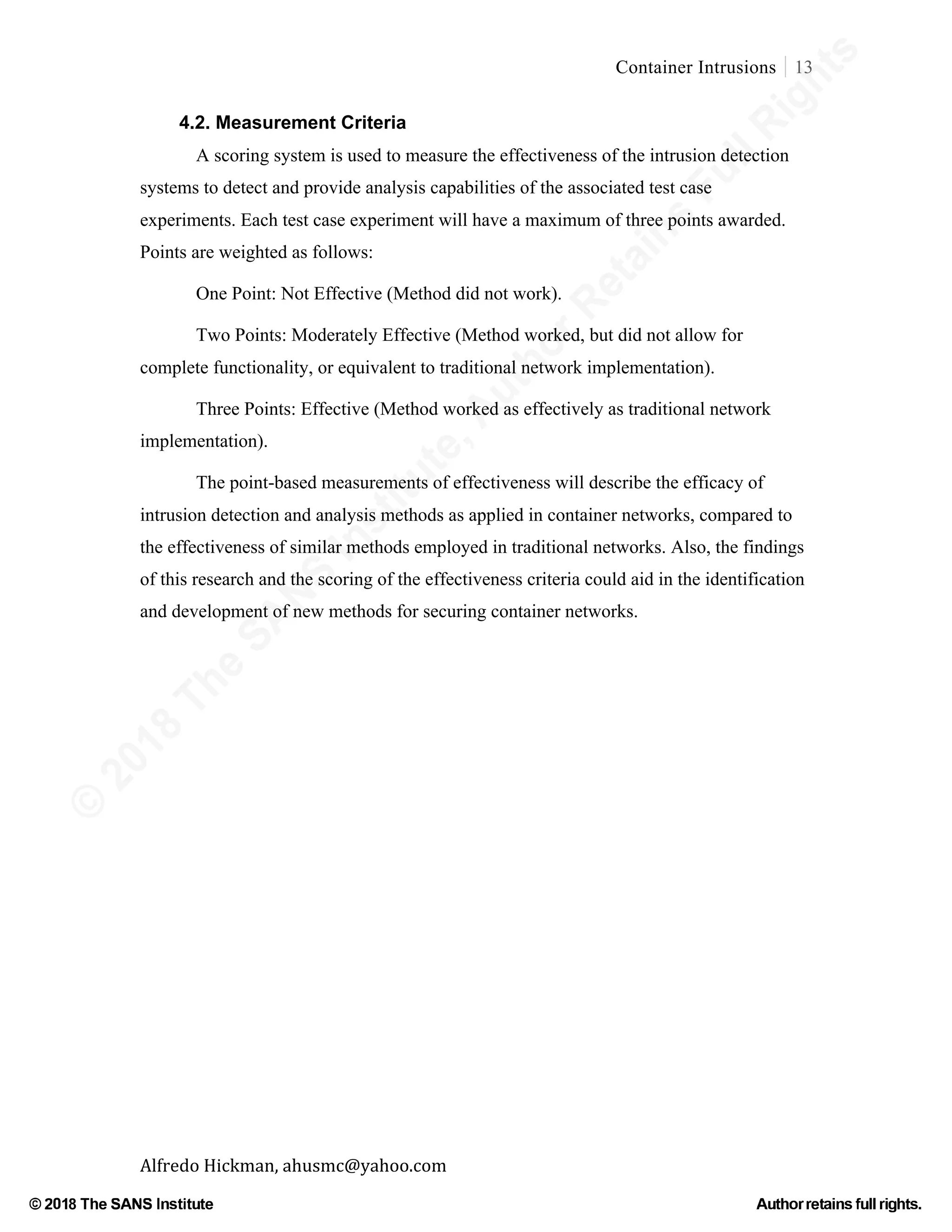
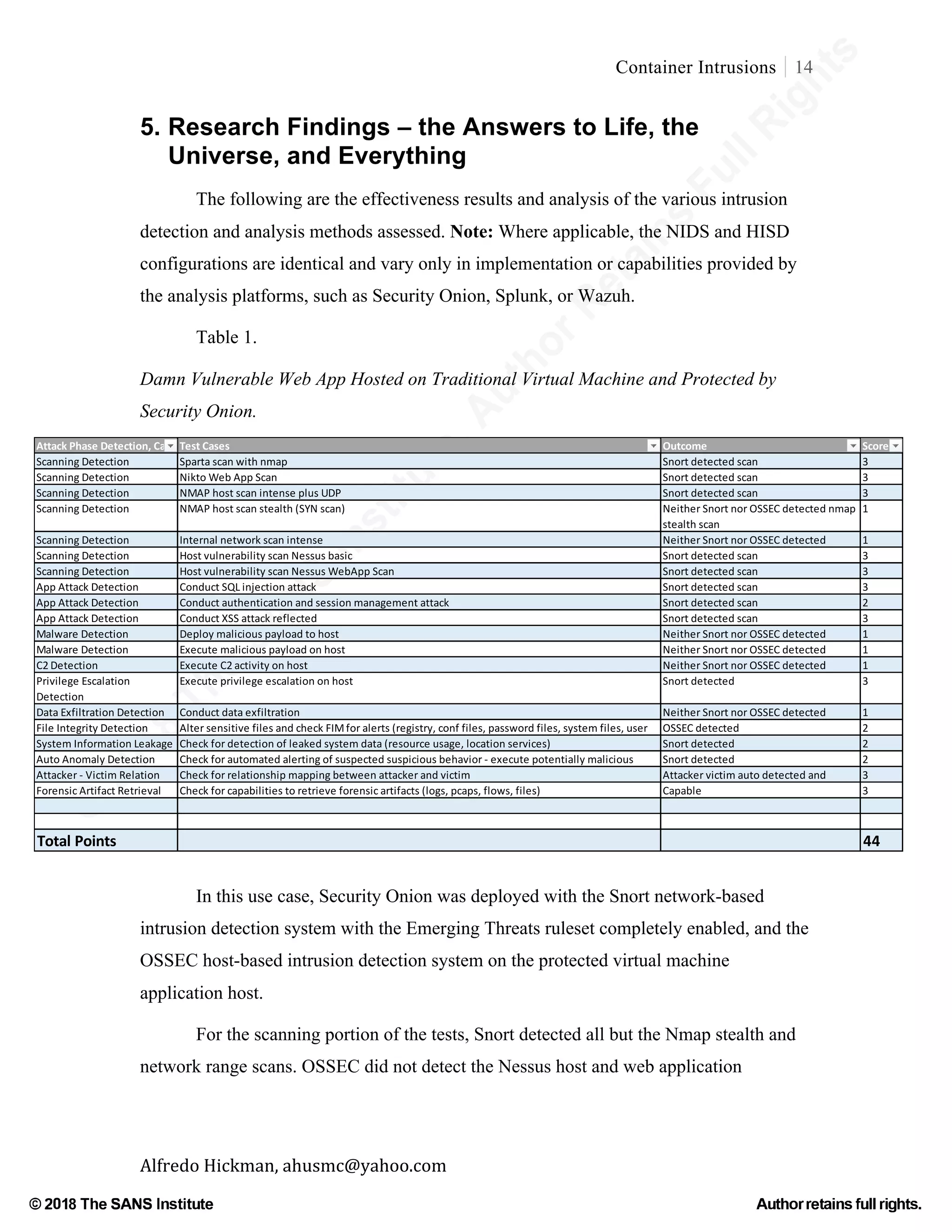
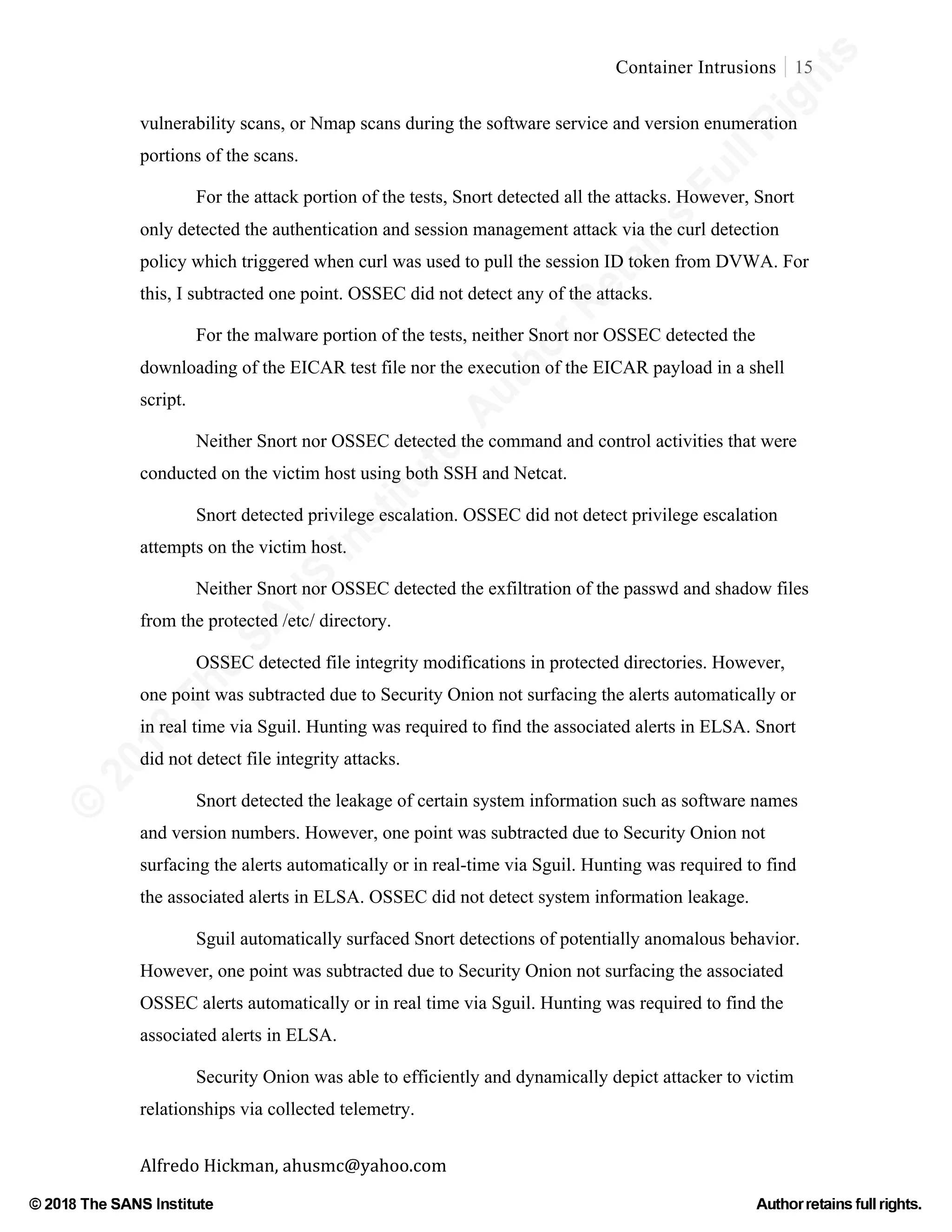
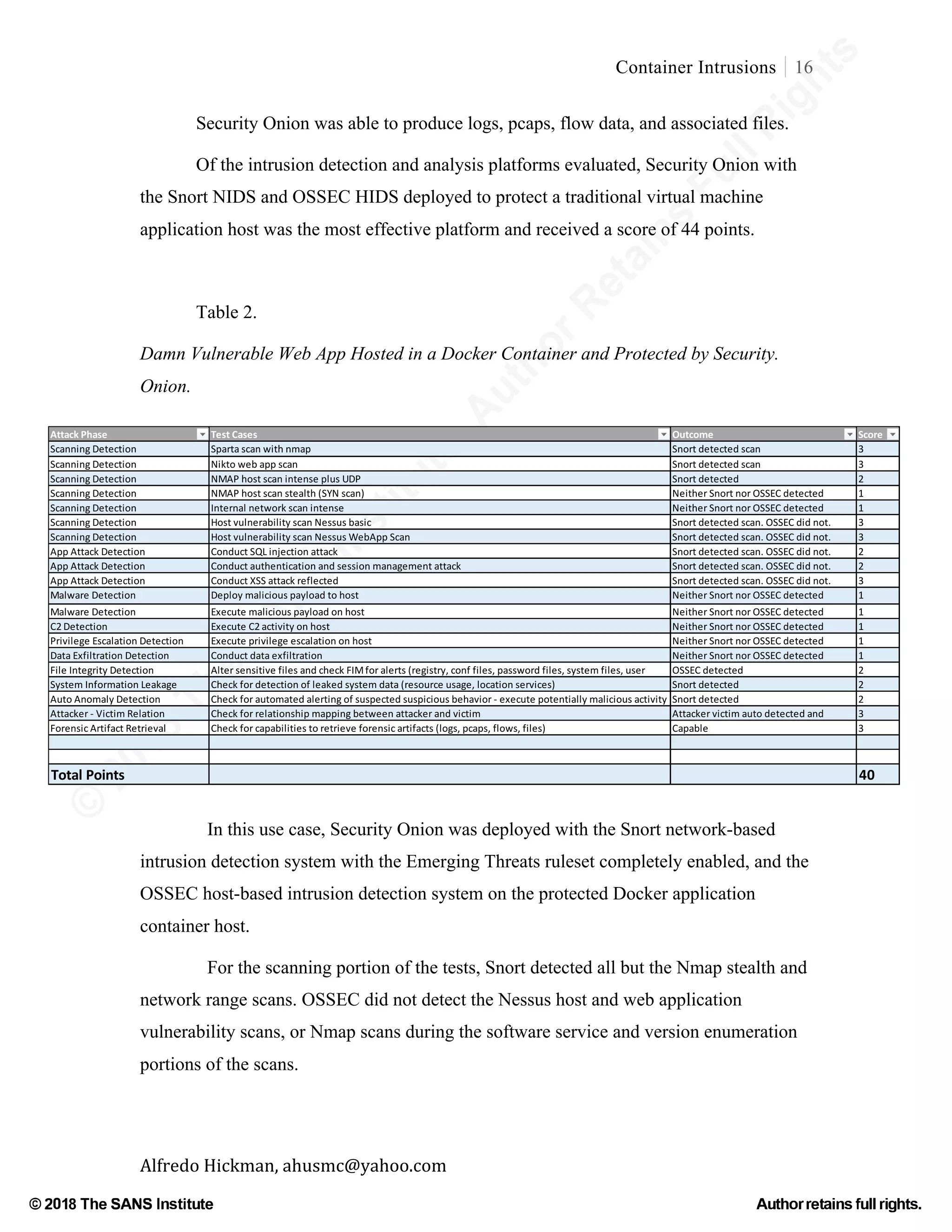
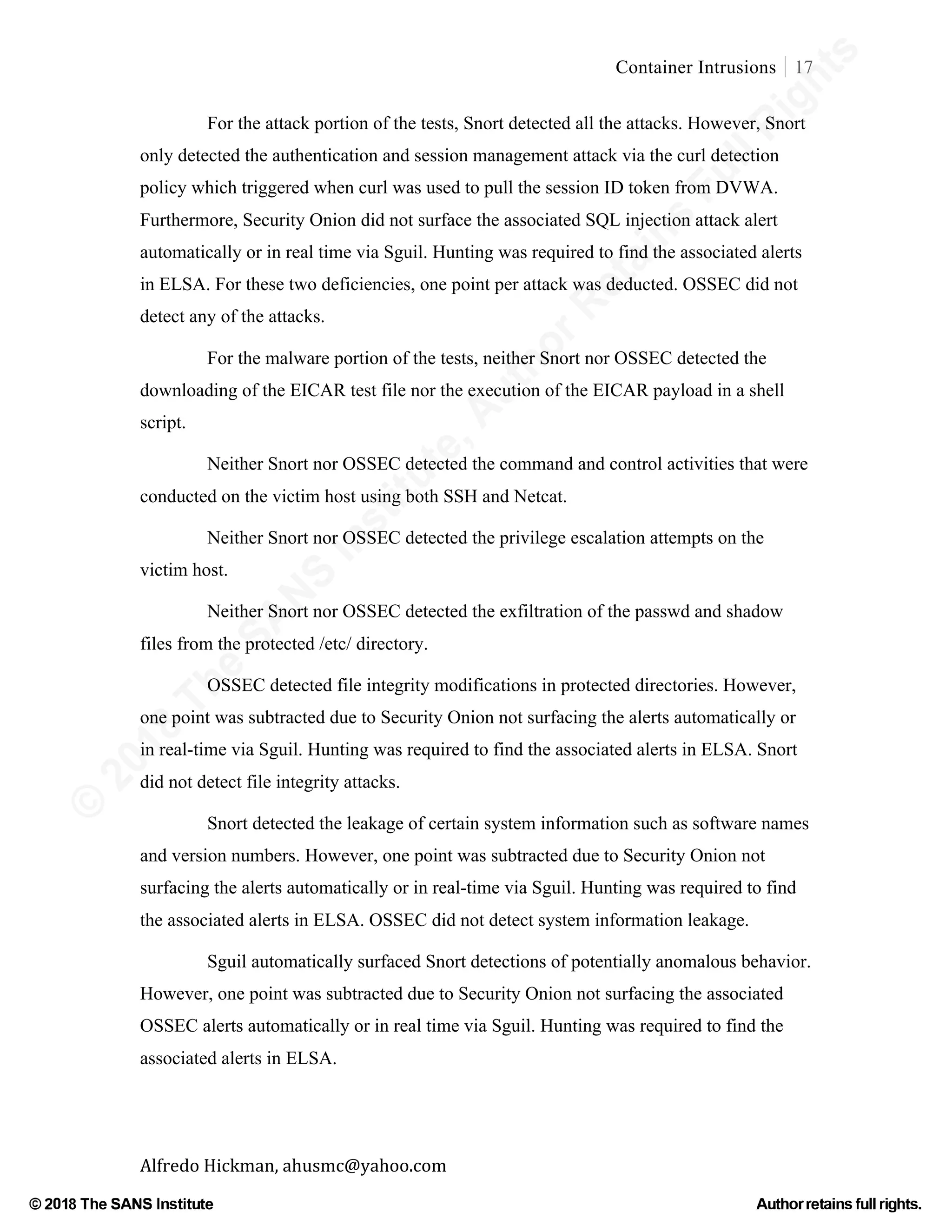
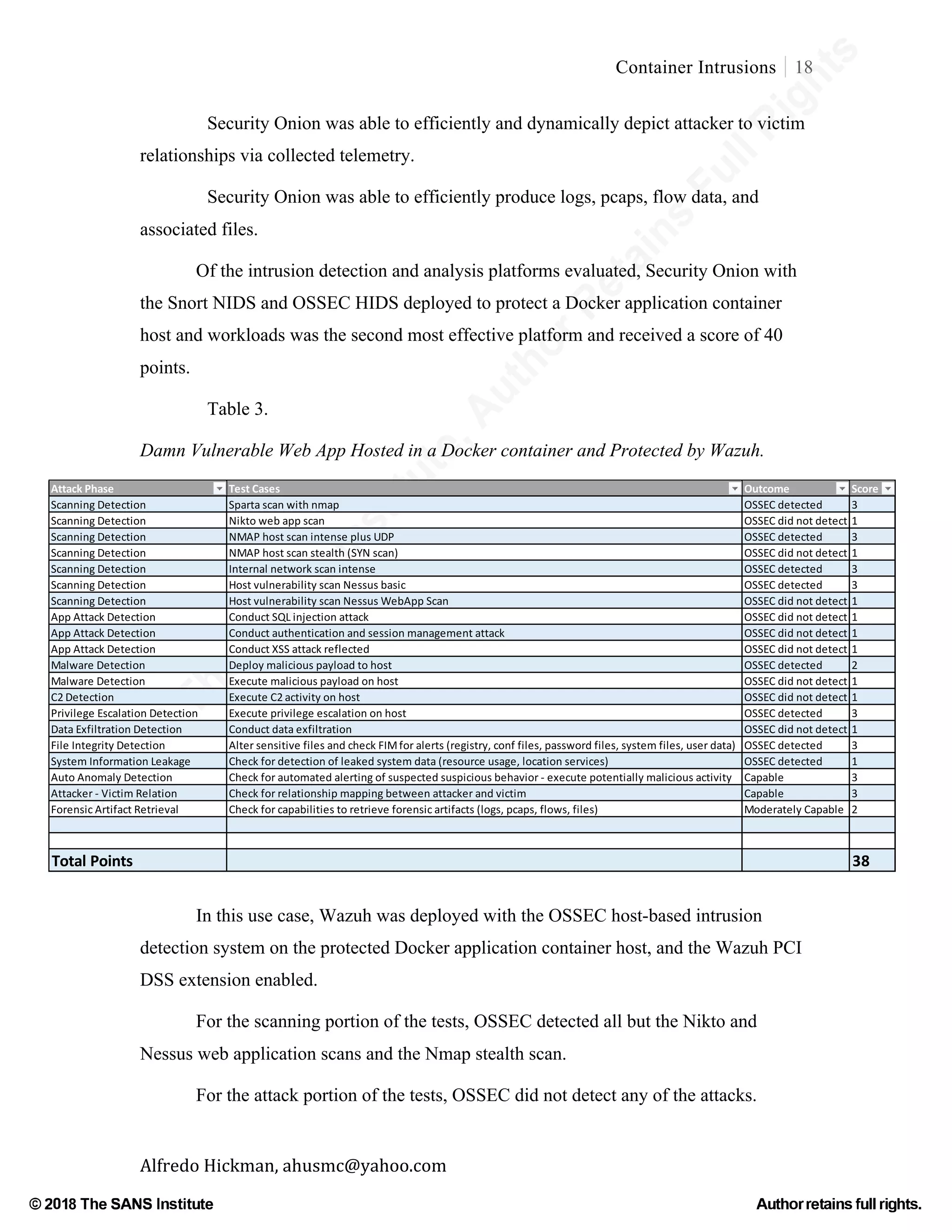
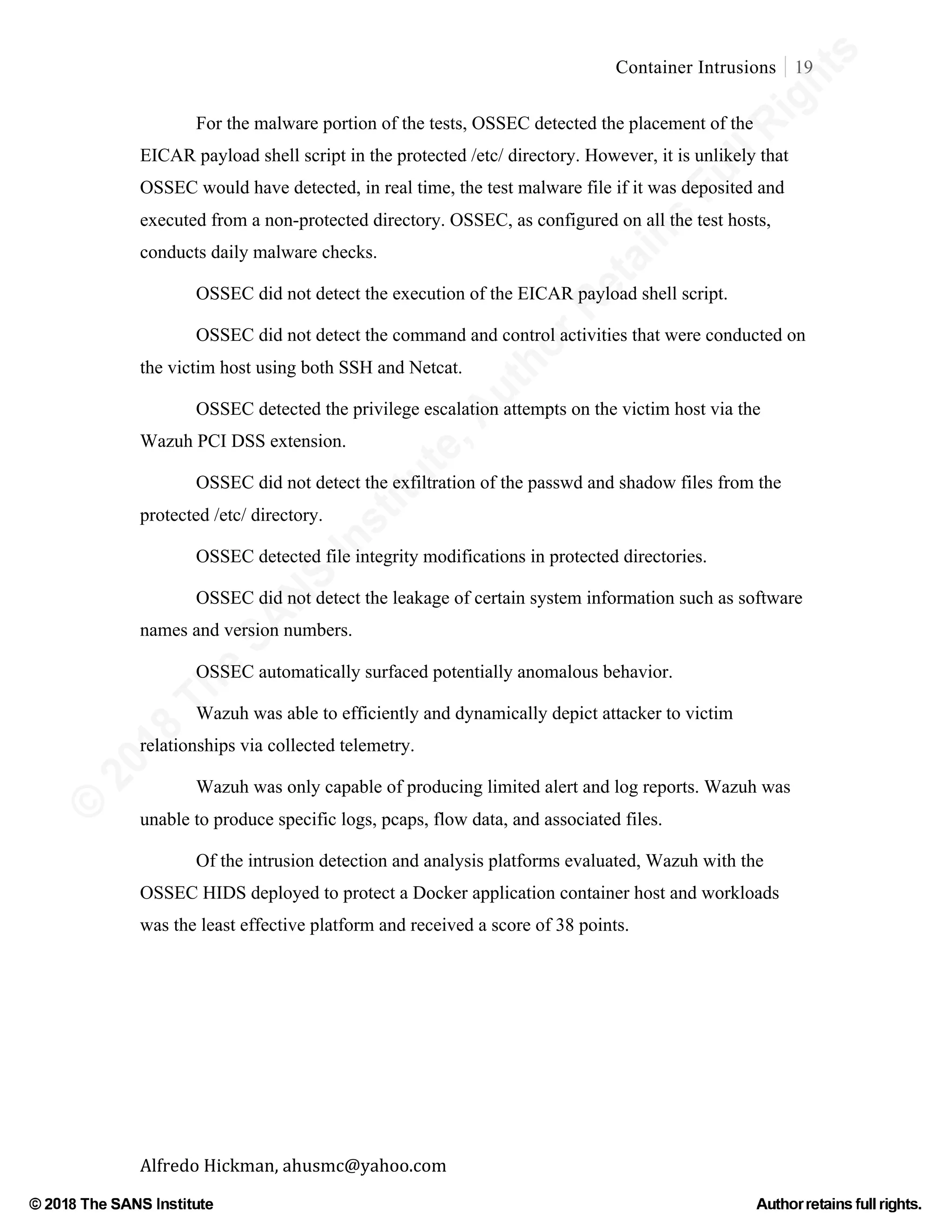
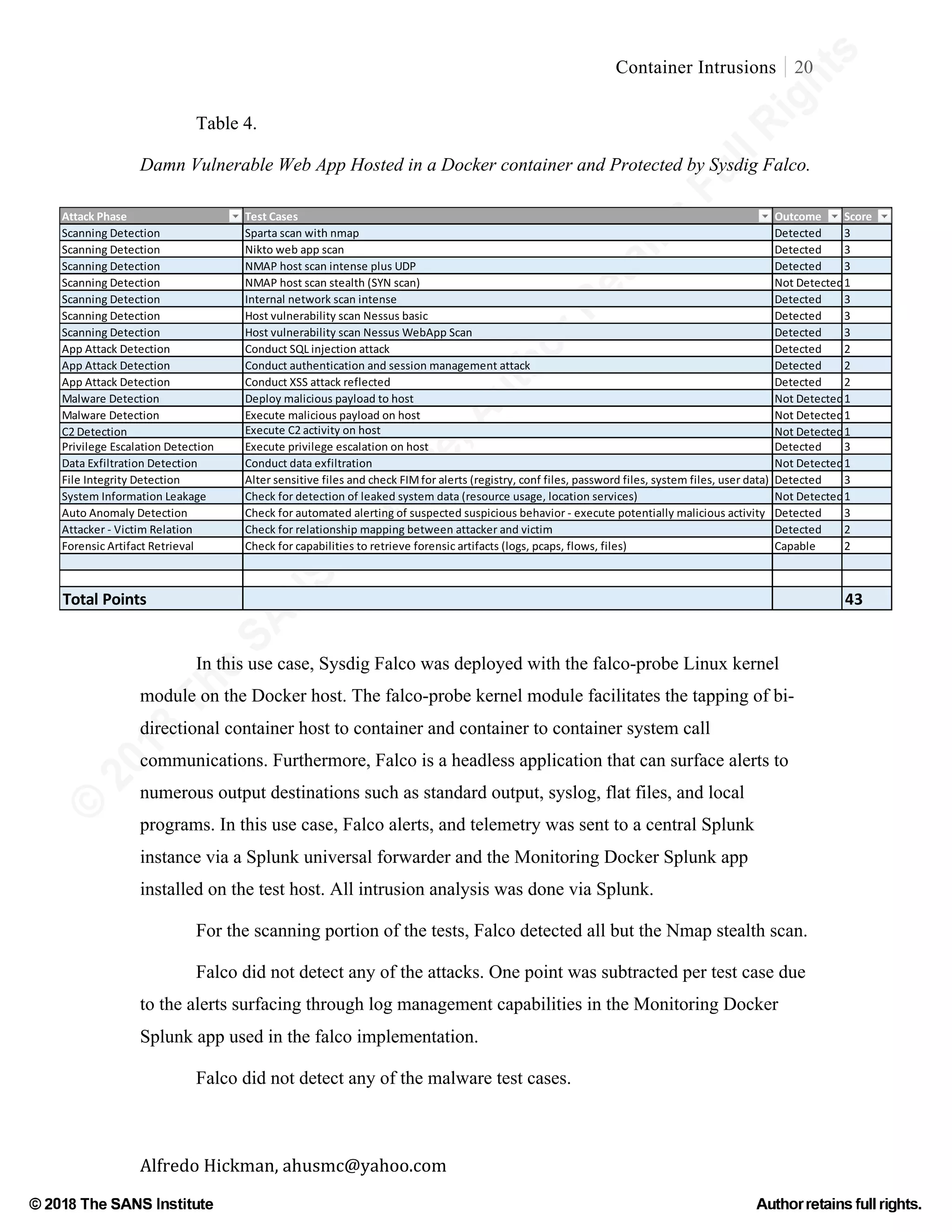
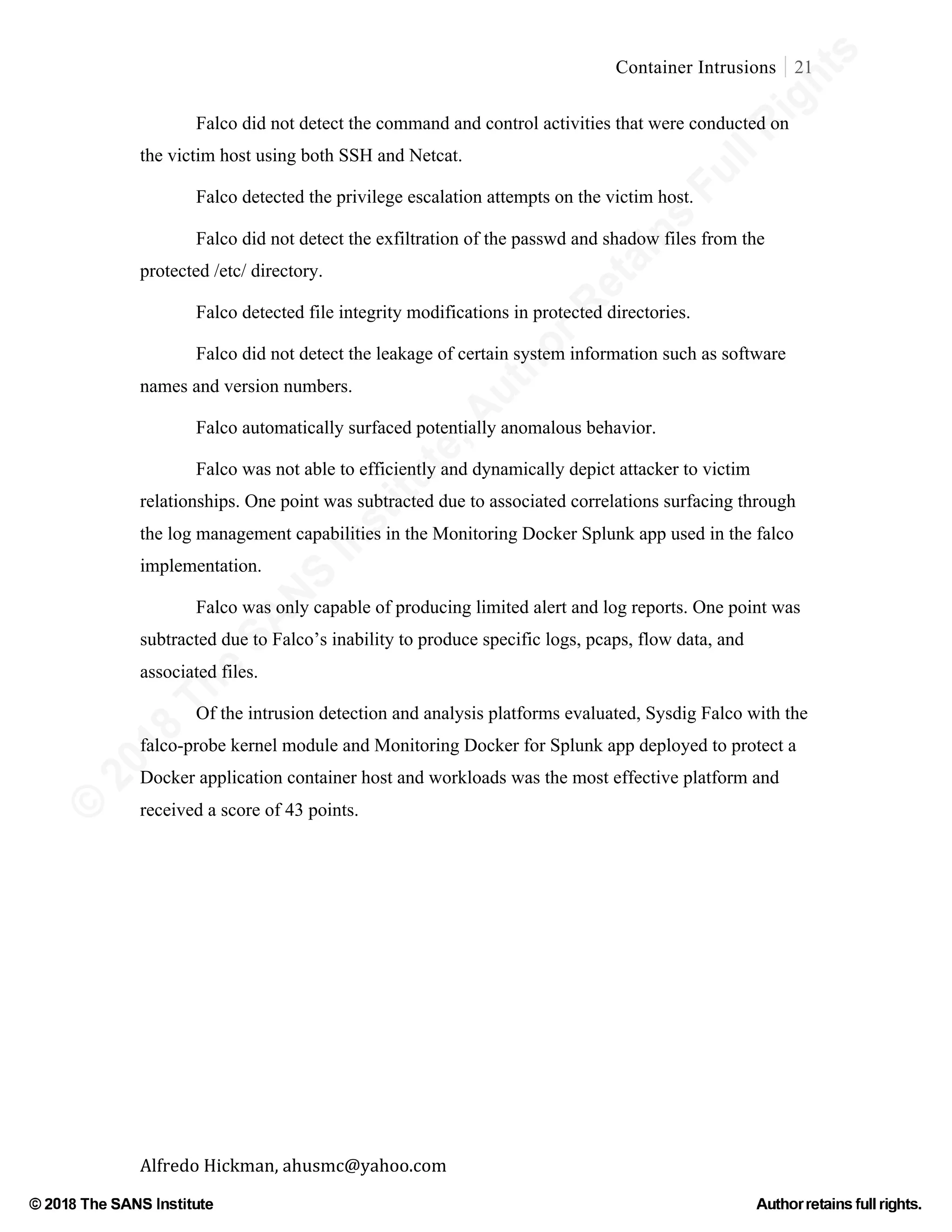
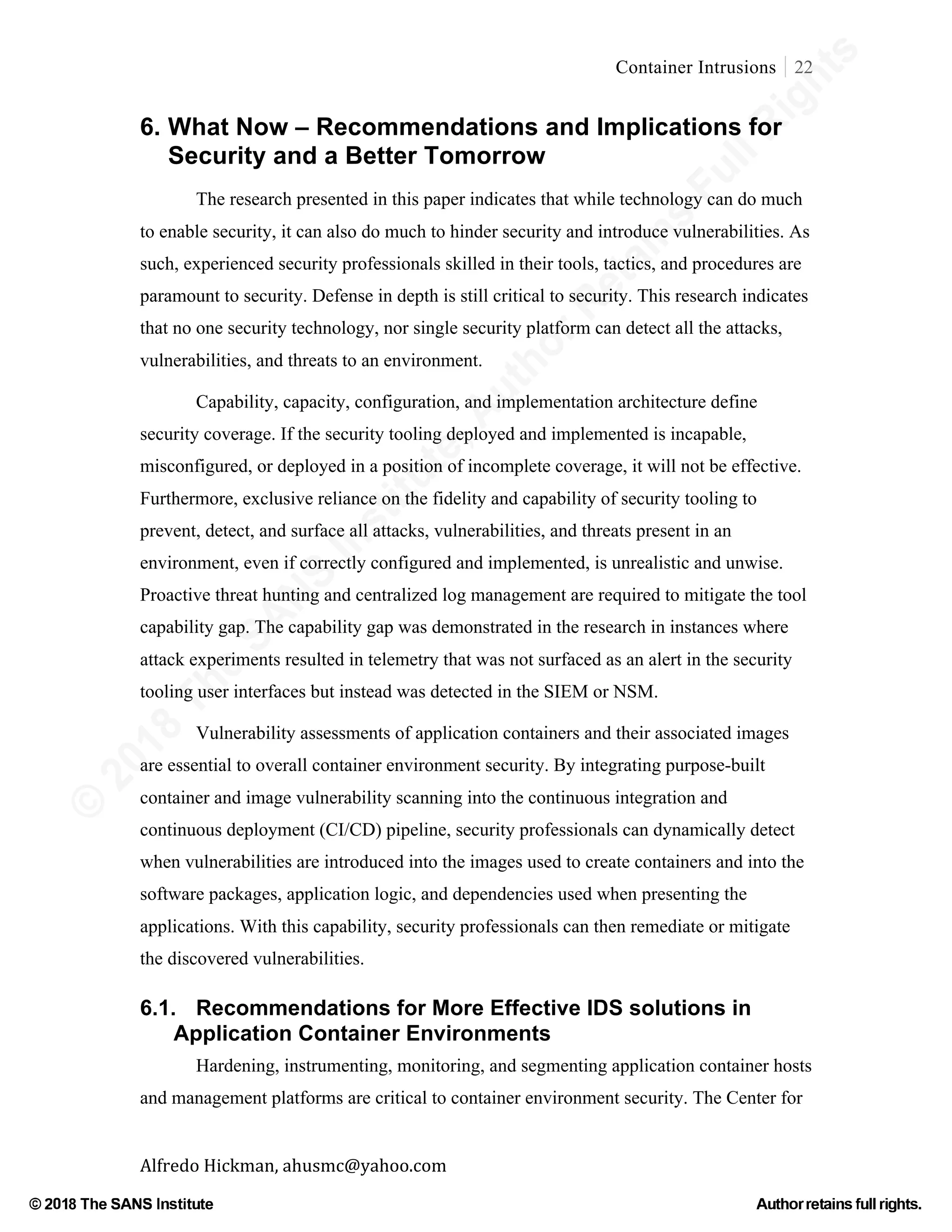
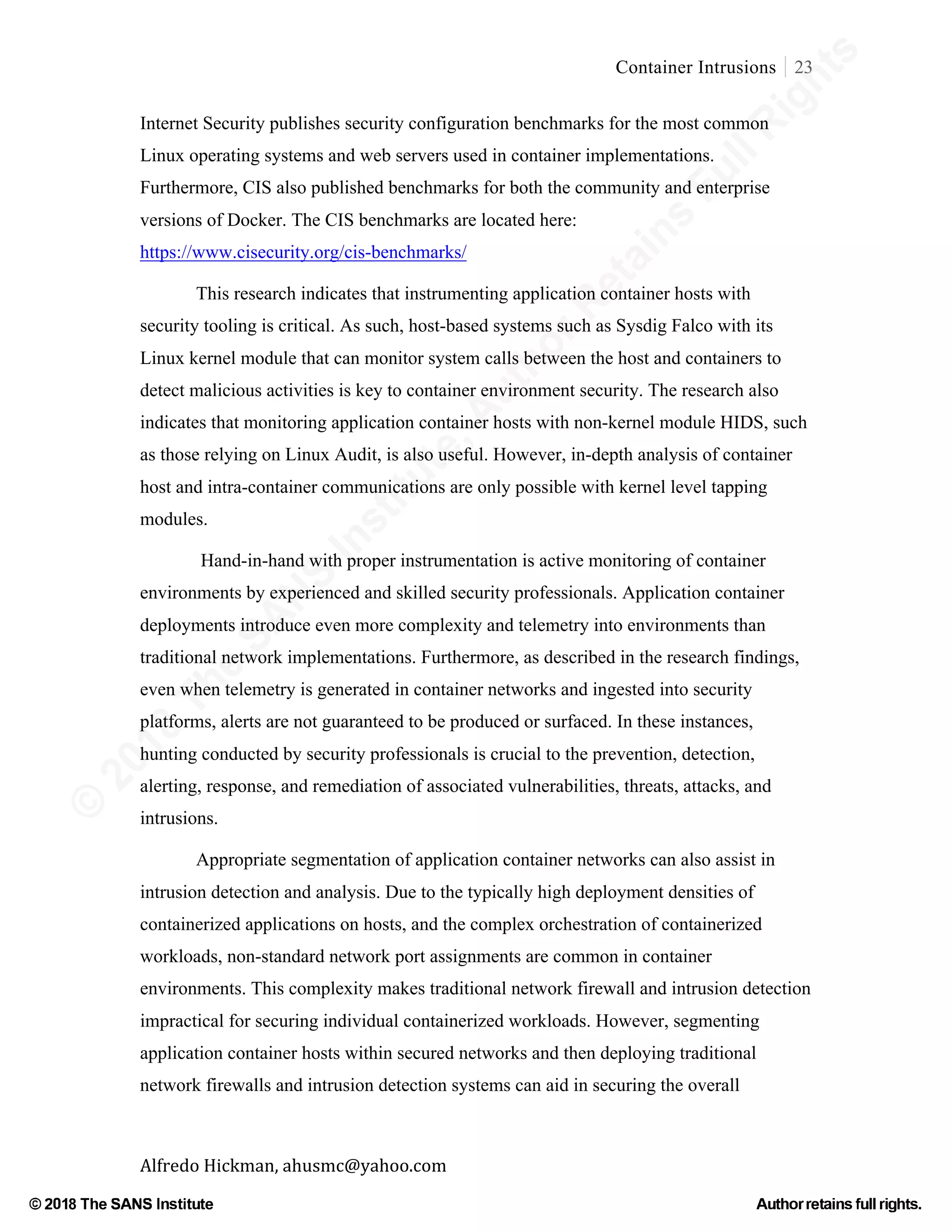
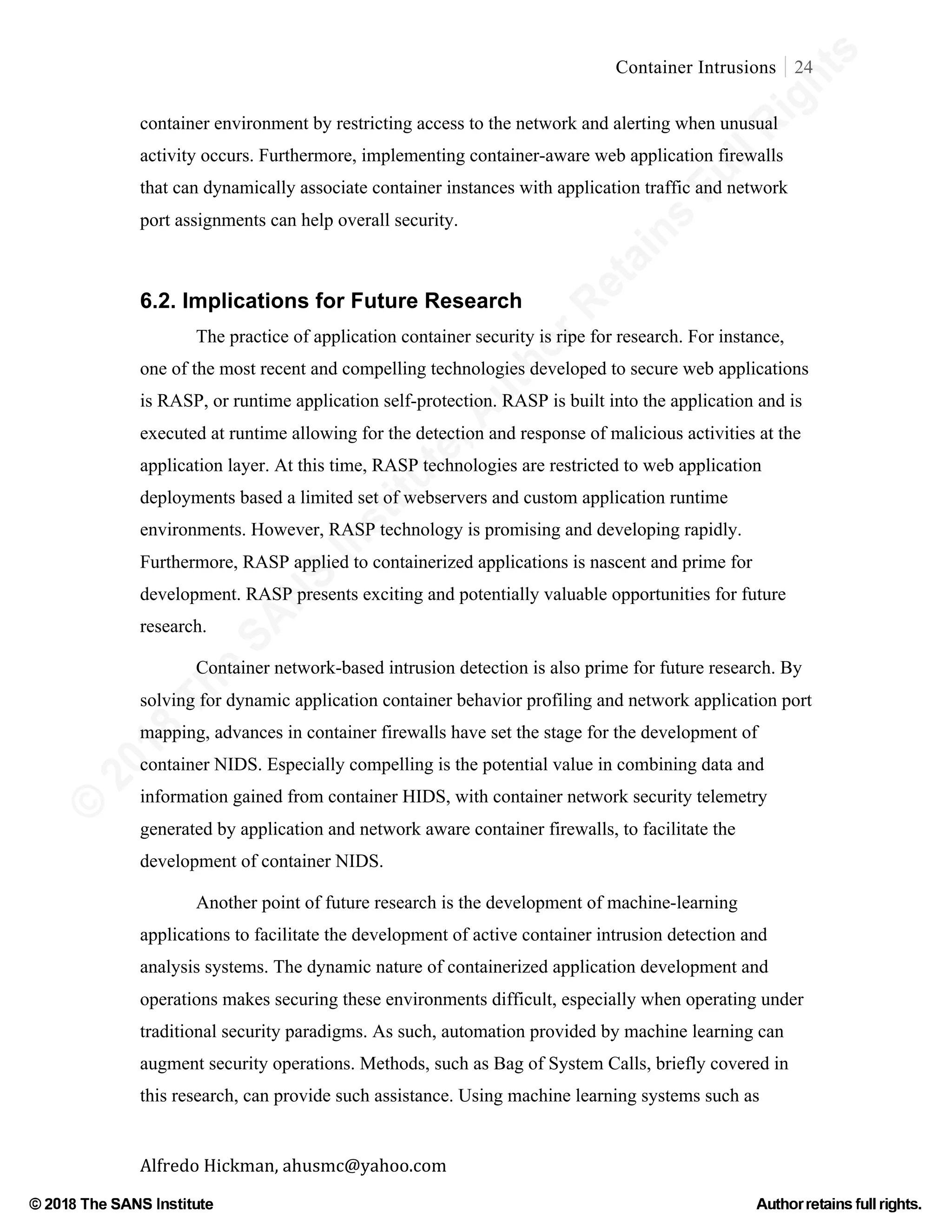
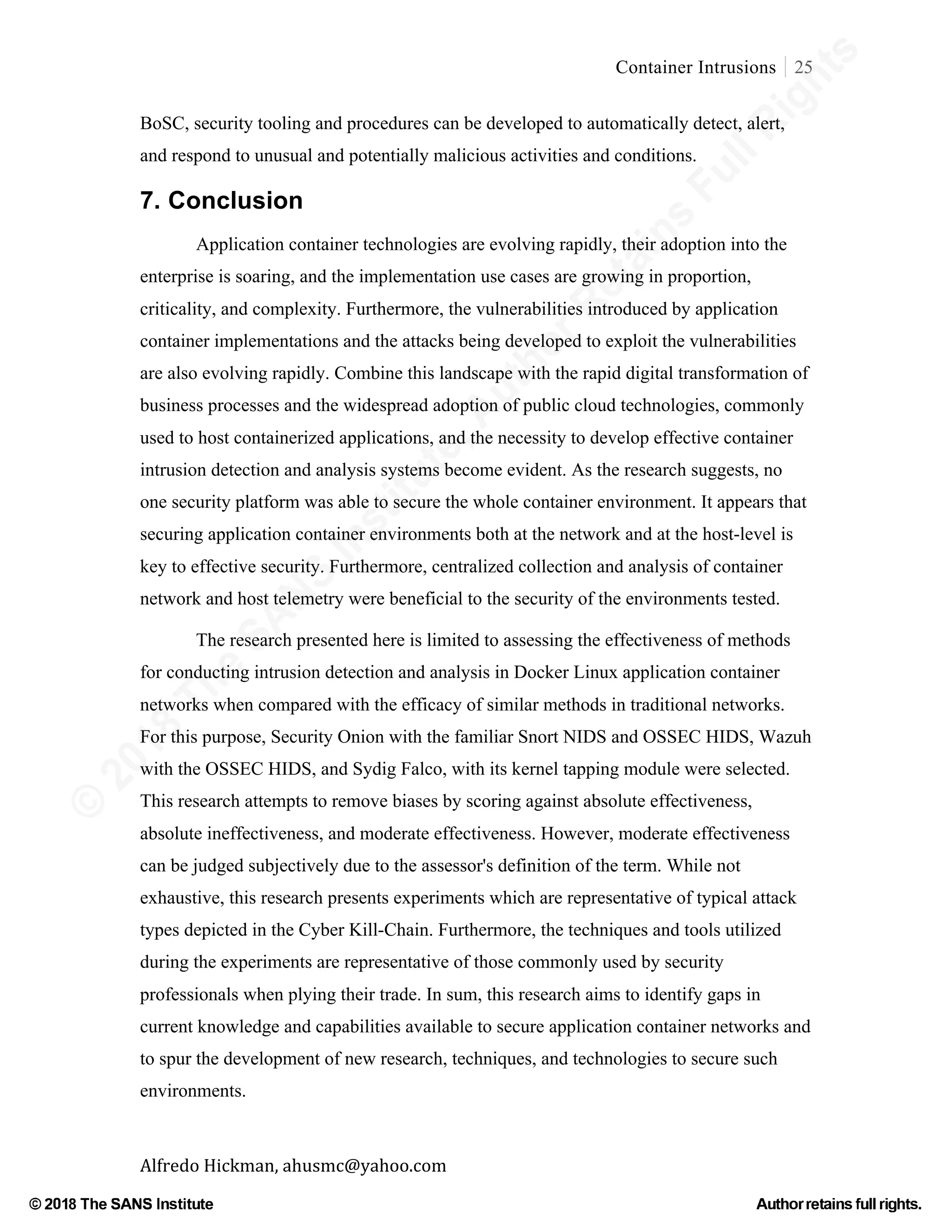
![©
2018
The
SANS
Institute,AuthorRetains
FullRights
© 2018 The SANS Institute Author retainsfull rights.
Container Intrusions 26
Alfredo Hickman, ahusmc@yahoo.com
References
Abed, A. S., Clancy, C., & Levy, D. S. (2015). Intrusion Detection System for Applications
Using Linux Containers. Security and Trust Management Lecture Notes in Computer
Science, 123-135. doi:10.1007/978-3-319-24858-5_8
Alonso, A. A. (n.d.). Intrusion Detection Through Relationship Analysis. Retrieved August 22,
2016, from https://www.sans.org/reading-room/whitepapers/detection/intrusion-
detection-relationship-analysis-37352
Accessed from the SANS Reading Room
Bejtlich, R. (2013). The Practice of Network Security Monitoring: Understanding Incident
Detection and Response. San Francisco: No Starch Press.
Bosco, P. (2016, January 20). Intrusion Detection and Prevention Systems Cheat Sheet:
Choosing the Best Solution, Common Misconfigurations, Evasion Techniques, and
Recommendations. Retrieved February 22, 2017, from https://www.sans.org/reading-
room/whitepapers/detection/intrusion-detection-prevention-systems-cheat-sheet-
choosing-solution-common-misconfigurations-evasion-techniques-recommendations-
36677
Accessed from the SANS Reading Room
Bottomley, J., & Emelyanov, P. (2014). Operating Containers. USENIX, 39(5). Retrieved
December 11, 2017, from
https://www.usenix.org/system/files/login/articles/login_1410_02-bottomley.pdf
Goyal, P. (2017, July 6). CIS Docker Community Edition Benchmark [PDF]. East Greenbush:
Center for Internet Security.](https://image.slidesharecdn.com/containerintrusions-assessingtheefficacyofintrusiondetectionandanalysismethodsforlinuxcontainerenvir-180114022312/75/Container-Intrusions-Assessing-the-Efficacy-of-Intrusion-Detection-and-Analysis-Methods-for-Linux-Container-Environments-27-2048.jpg)
![©
2018
The
SANS
Institute,AuthorRetains
FullRights
© 2018 The SANS Institute Author retainsfull rights.
Container Intrusions 27
Alfredo Hickman, ahusmc@yahoo.com
Davidoff, S., & Ham, J. (2012). Network Forensics Tracking Hackers Through Cyberspace.
Upper Saddle River: Prentice Hall.
Gao, X., Gu, Z., Kayaalp, M., Pendarakis, D., & Wang, H. (2017, June). ContainerLeaks:
Emerging Security Threats of Information Leakages in Container Clouds [PDF].
Williamsburg: College of William and Mary.
Presented at the 2017 47th Annual IEEE/IFIP International Conference on Dependable Systems
and Networks
Hayden, M. (2015, July 26). Securing Linux Containers. Retrieved February 23, 2017, from
https://www.sans.org/reading-room/whitepapers/linux/securing-linux-containers-36142
Accessed from the SANS Reading Room
Hosburgh, M. (n.d.). Offensive Intrusion Analysis: Uncovering Insiders with Threat Hunting and
Active Defense. Retrieved July 6, 2017, from https://www.sans.org/reading-
room/whitepapers/detection/offensive-intrusion-analysis-uncovering-insiders-threat-
hunting-active-defense-37885
Accessed from the SANS Reading Room
HOW TO SECURELY CONFIGURE A LINUX HOST TO RUN CONTAINERS [PDF].
(2017). San Francisco: Twistlock.
Accessed from https://www.twistlock.com/resources/securely-configure-linux-host-run-
containers/
Hykes, S. (Writer). (2017, November 20). The future of Linux Containers. Live performance in
Pycon U.S. 2013: Santa Clara Convention Center, Santa Clara.](https://image.slidesharecdn.com/containerintrusions-assessingtheefficacyofintrusiondetectionandanalysismethodsforlinuxcontainerenvir-180114022312/75/Container-Intrusions-Assessing-the-Efficacy-of-Intrusion-Detection-and-Analysis-Methods-for-Linux-Container-Environments-28-2048.jpg)
![©
2018
The
SANS
Institute,AuthorRetains
FullRights
© 2018 The SANS Institute Author retainsfull rights.
Container Intrusions 28
Alfredo Hickman, ahusmc@yahoo.com
Kennedy, C. (2016, June 29). Deception Techniques as Part of Intrusion Detection Strategy.
Retrieved February 22, 2017, from https://www.sans.org/reading-
room/whitepapers/detection/deception-techniques-intrusion-detection-strategy-37140
Accessed from the SANS Reading Room
Lockheed Martin Corporation. (n.d.). The Cyber Kill Chain [Brochure]. Author. Retrieved
October 23, 2018, from https://www.lockheedmartin.com/us/what-we-
do/aerospace-defense/cyber/cyber-kill-chain.html
Mohallel, A. A., Bass, J. M., & Dehghantaha, A. (2016). Experimenting with docker: Linux
container and base OS attack surfaces. 2016 International Conference on Information
Society (i-Society). doi:10.1109/i-society.2016.7854163
Petazonni, J. (2015, August 15). Anatomy of a Container: Namespaces, cgroups & Some
Filesystem Magic. Retrieved July 30, 2017, from
https://www.slideshare.net/jpetazzo/anatomy-of-a-container-namespaces-cgroups-some-
filesystem-magic-linuxcon
Presentation at LinuxCon 2015
Robinson, A. (2016, November 18). A Checklist for Audit of Docker Containers. Retrieved
February 23, 2017, from https://www.sans.org/reading-
room/whitepapers/auditing/checklist-audit-docker-containers-37437
Accessed from the SANS Reading Room
Souppaya, M., Morello, J., & Scarfone, K. (n.d.). Draft (2nd) NIST Special Publication 800-190
Application Container Security Guide (USA, NIST). Retrieved July 13, 2017, from
http://csrc.nist.gov/publications/drafts/800-190/sp800-190-draft2.pdf](https://image.slidesharecdn.com/containerintrusions-assessingtheefficacyofintrusiondetectionandanalysismethodsforlinuxcontainerenvir-180114022312/75/Container-Intrusions-Assessing-the-Efficacy-of-Intrusion-Detection-and-Analysis-Methods-for-Linux-Container-Environments-29-2048.jpg)
